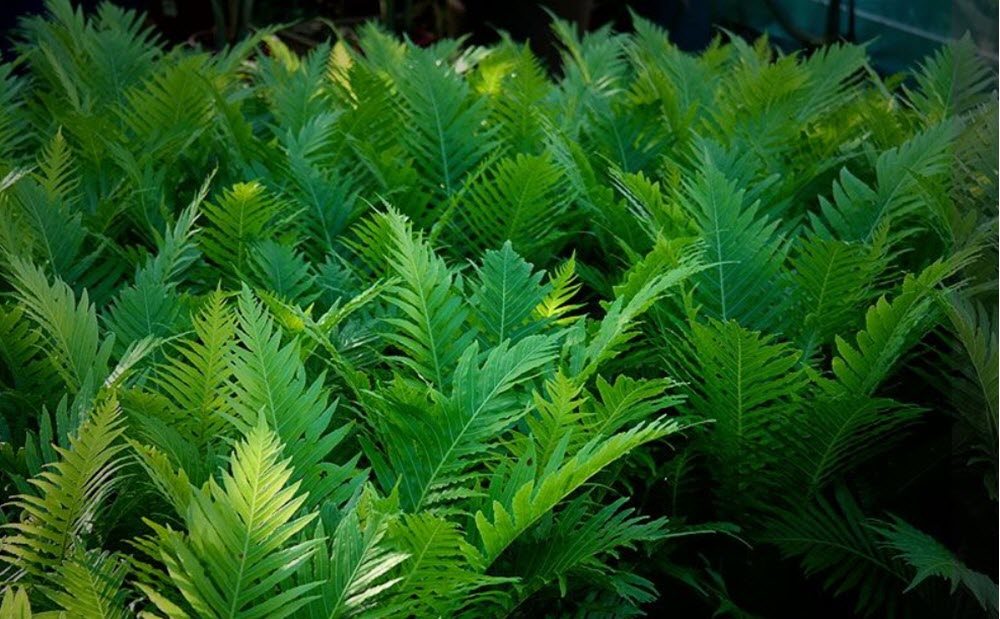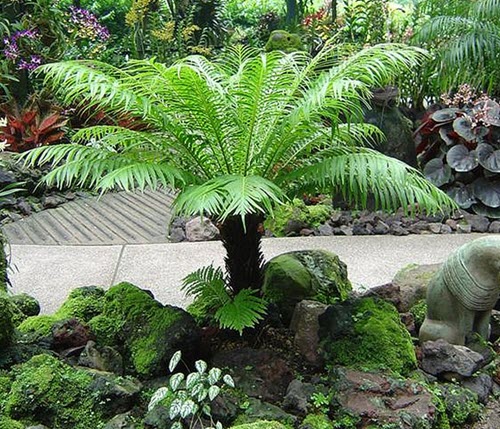Contents
This fern is known by several different names in English, including Silver Lady Fern and Dwarf Tree Fern. This small tree farn is a popular houseplant and garden plant known to develop broad fronds.

Many tree ferns have a well-deserved reputation for slow growth, but the Blechnum gibbum grows comparatively fast in good conditions and the fronds doesn´t need that much time to spread to over one metre.
Silver Lady Fern plants are often planted close together under trees to form a cohesive undergrowth in the garden. As a potted plant, it will hold its own as a focal plant in a big pot indoors or on the patio.
Native range and habitat
The Silver Lady Fern is native to Fiji, New Caledonia and the Pacific Islands.
In the wild, it is an under story plant found in high-humidity forested areas. It is adapted to filtered light, a high air humidity and moist (but not wet) soil.
Description
This is a small tree fern that can reach a height of circa 120 cm.
It produces a neat, symmetrical rosette of fronds. The fronds ca be up to 90 cm long and 30 cm wide, and each frond have many leaflets. The leaflets are green and slightly drooping.
The trunk is scaly and black.
Short info
Scientific name: Blechum gibbum
Family: Blechnaceae
Shape: rosette
Height 90-120 cm
Width: 60-90 cm
Foliage: green
Watering: water plentifully during the active growth period, and moderately during the resting period
Light: bright but filtered
Humidity: high
Temperature: 18-27°C for the active growth period, 10-16°C for the rest period
Keeping Silver Lady Fern as a houseplant or in the garden
Potting medium
The ideal potting medium is one that drains well but is easy to keep moist (not wet). Compost-enriched and slightly acidic soil is recommended, and mulching can be used to retain moist.
Light and position
The Silver Lady Fern enjoys a bit of bright light, but not strong direct sunlight. It is known to thrive in shaded and semi-shaded areas where it recieves indirect or filtered bright light that wont scorch the foliage.
Since it is very fond of moist air, it loves being planted next to streams, ponds and other water features in the garden. Inside the home, it can benefit from having its pot stand on top of pebbles in a tray of water during the growth season.
Temperature
 For the growth period (when the days are long), the Blechnum gibbum fern prefers an environment that is warm but not hot. Humid air is beneficial during the growht period. If the air is humid enough, these ferns can handle temperatures up to 27°C well. The recommended range is 18-27°C, but if the temperature is kept in the upper range of the span, it becomes very important to make the air humid, e.g. by placing the pot on top of pebbles above a water-filled tray.
For the growth period (when the days are long), the Blechnum gibbum fern prefers an environment that is warm but not hot. Humid air is beneficial during the growht period. If the air is humid enough, these ferns can handle temperatures up to 27°C well. The recommended range is 18-27°C, but if the temperature is kept in the upper range of the span, it becomes very important to make the air humid, e.g. by placing the pot on top of pebbles above a water-filled tray.
The recommendet temperature range for the resting period (when days are short) is 10-16°C. If the temperature drops below 12°C it becomes especially important to decrease the watering, to encourage the plant to go into proper deep-rest.
Blechnum gibbum ferns grow in a wide range of climates, from temperate to sub-tropical, but this doesn´t mean they like rapid swings between temperature extremes. Also, it is important to coordinate watering and air humidity with the temperature if you want them to thrive.
It is generally not regarded as a frost-tolerant plant, although there are reports of individual Blechnum gibbum ferns that have survived -4°C and plants that have re-grown after being frozen. The fronds will be damanged by the cold and turn black, but if the plant survives, it will produce new growth in spring.
Watering
The Blechnum gibbum is intolerant to lime and likes rainwater.
Do not water on the foliage.
During the growth period, water the plant frequently enough to always keep the potting medium moist (not wet). If the fern is allowed to stand in water, root rot can develop.
When the temperature is below 12°C during the resting period, water more sparsely. Wait for the top 1 centimetre of the potting medium to dry out before you add more water.
Nutrients
For our potted Blechnum gibbum ferns, we feed half-strength liquid fertilizer once a month during the active growth period.
Outdoors, a slow-release fertiliser should be applied in early spring. If the fern shows sign of needing more nutrients, add half-strength liquid fertilizer throughout the growth period.
Repotting
When roots can be seen on the surface of the potting medium, it is time to repot the fern.
